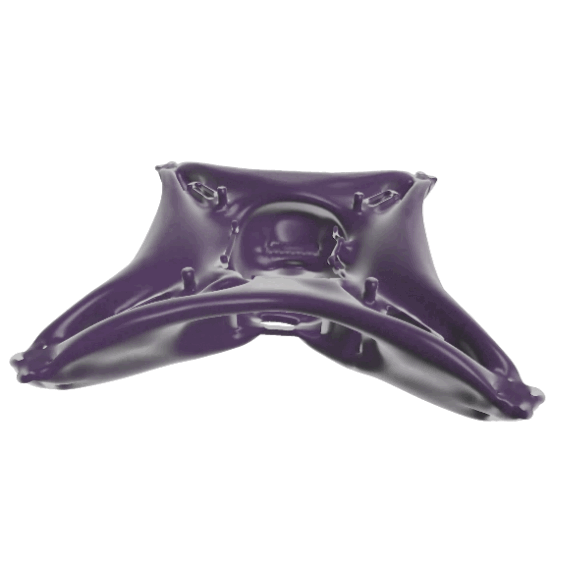3D Printing Software
May 21st, 2020
Effectively implementing 3D printing in a production environment requires software tools for design, simulation, pre-processing, distribution, manufacturing, inspection, and quality. Printer manufacturers (OEMs) provide software with their printers, but it often does not include all the functionality necessary for industrial scale additive manufacturing (AM). This post covers the different categories of 3D printing software, how they fit together in an AM workflow, and the leading companies providing commercially available solutions.
Design (CAD)

Autodesk generative design software
There is a special class of design software referred to as “generative design” or “topology optimization” (GD/TO) which optimizes part geometry to achieve a desired performance given a defined loading scenario, boundary conditions, and design constraints. This software relies upon iterative computer simulations to refine the part geometry, combining CAD design rules with simulations from computer-aided engineering (CAE) tools. Leading providers of GD/TO software include Altair, Autodesk, and Paramatters.
Simulation (CAE)
Flow3D L-PBF process simulation software
In addition to their use in improving overall print quality, CAE tools serve an important role in helping to optimize parameters such as print speed and energy and material inputs - important factors in the economics of 3D printing. CAD and CAE together provide the foundational data needed to perform the subsequent step of developing the manufacturing instructions for the printer.
Processing (CAM)
- Determine Part Orientation:
The best way to orient a part within the build depends on a variety of factors such as accuracy and surface finish requirements, process physics, support structures, and optimal nesting (see below). CAM can suggest optimal orientations but usually requires user input.
- Support Generation
There are many different approaches to supporting a part. The optimal support structure depends on its geometry, the process, material, and other variables. This step is largely automated in most CAM software.
- Near-net-shape Expansion:
For near-net-shape processes and applications, additional material (“stock”) is often defined in CAM to be added to surfaces with high surface finish and accuracy requirements. The stock material is removed through post-processes like machining.
- Nesting:
Some 3D printing processes can accommodate printing many parts at once, distributed across the print plate and even stacked in the z-axis. CAM software helps to nest parts in order to maximize the number of parts per build without sacrificing the quality which is impacted by the build layout.
- Slicing and Toolpath Generation:
Once all the above steps are complete and any custom print parameters selected, CAM software generates g-code which is sent to the printer to perform the printing process.
Materialise’ Magics Support Generation Module for Metal 3D Printing
Almost all printers come “out of the box” with CAM software from the OEM that includes the basic functionality needed to operate the equipment. More advanced industrial AM users typically leverage 3rd party processing tools for more control and efficiency. This stand-alone CAM software can prove beneficial in processing computationally demanding, complex, high-resolution builds. It also allows the use of one API with a fleet of different 3D printing equipment. Tools such as Netfab (Autodesk), Magics (Materialise), and Dyndrite are popular for these purposes.
Workflow (MES/ERP/PLM)
QA & Security
Securing AM supply chains and all their associated data is another important software requirement. Protecting designs, process parameters, IP, trade secrets, and other proprietary information requires end-to-end data management and encryption. Additionally, to safely leverage AM for de-centralized, just-in-time manufacturing, companies have developed security software to prevent the proliferation of parts that don’t meet quality standards, or which were not authorized to be produced in the first place. LEO Lane, Identify3D, and Authentise are some of the companies that have developed software solutions filling this need.
Printer OEM Software
As previously mentioned, industrial printers are packaged with machine-specific software addressing some, but rarely all, of the critical needs in 3D printing production workflows. Almost all OEM software is designed for the OEM’s specific printers and is not compatible across a broad range of equipment. For this reason, OEM specific software, despite some of it being quite impressive, was omitted from this analysis. This post focuses on standalone software solutions that are broadly useful and not specific to a narrow range of printing processes, equipment, applications, or materials.
The Future of 3D Printing Software
Regardless of the future shape of the 3D printing landscape, software will continue to be a critical element in moving the industry forward. Many of the technical challenges facing 3D printing – design optimization, process consistency, part quality, print speed – are, at least in part, addressed and improved with software. At the end of the day, one of the key advantages of additive manufacturing is that it is a fundamentally digital process. This means it is only as good as the software which it is running on – and there are many sophisticated 3D printing software companies working tirelessly to ensure its advancement. Continued investment and maturation of 3D printing software will help increase AM’s competitiveness with established, conventional supply chains.
Please check out other posts in our blog series:
Digital Alloys’ Guide to Metal Additive Manufacturing
Learn about the technology behind our process:

Alex Huckstepp
VP Business Development

Digital Alloys is committed to providing the technology and expertise manufacturers need to use metal additive manufacturing in production — enabling them to save time, shrink costs, and produce valuable new product.
